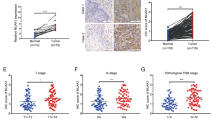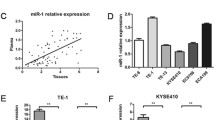Abstract
To distinguish aggressive esophageal squamous cell carcinoma from indolent disease is the important clinical challenge. Studies have indicated that metastasis-associated gene 1(Mta1) played a role in the process of metastasis of carcinoma. The overexpression of Mta1 gene has been found in a variety of tumors. To identify the detailed roles of MTA1 protein in the carcinogenesis of esophageal squamous cell carcinoma, this study analyzed the pathological specimens on tissue microarray derived from 72 patients using immunohistochemistry. MTA1 expression increased in the nuclear with the development of esophageal squamous cell carcinoma from normal epithelial cell, dysplasia, to invasive cancer. In biological studies with human esophageal squamous cell carcinoma cell line, MTA1 plays its roles to promote cancer cell invasion, adhesion and movement. RNA interference (RNAi) against MTA1 decreased the malignant phenotypes. Gene microarray analysis revealed some metastasis-associated genes were altered by MTA1 RNAi. This study started an effective beginning to explore metastasis mechanisms and cancer gene therapy strategy targeting MTA1.
Similar content being viewed by others
Abbreviations
- Mta1:
-
metastasis-associated gene 1
- RNAi:
-
RNA interference
- siRNA:
-
small interfering RNA
- MTA1-siRNA:
-
small interfering RNA for MTA1
- Control-siRNA:
-
small interfering RNA for control PBS phosphate buffered saline
- TSLC1:
-
tumor suppressor in lung cancer 1
- VEGF:
-
vascular endothelial growth factor
- GAPDH:
-
Glyseraldehyde-3-phosphate dehydrogenase
- MDM2:
-
murine double minute 2
- HDAC:
-
histone deacetylase
- MMP:
-
Matrix Metalloproteinase
- RT-PCR:
-
reverse transcription-polymerase chain reaction
References
Sugimachi K, Matsuoka H, Ohno S et al (1988) Multivariate approach for assessing the prognosis of clinical oesophageal carcinoma. Br J Surg 75:1115–1118
Yoshinaga K, Inoue H, Utsunomiya T et al (2004) N-cadherin is regulated by activin A and associated with tumor aggressiveness in esophageal carcinoma. Clin Cancer Res 10:5702–5707
Ito T, Shimada Y, Hashimoto Y et al (2003) Involvement of TSLC1 in progression of esophageal squamous cell carcinoma. Cancer Res 63:6320–6326
Kato H, Yoshikawa M, Miyazaki T et al (2002) Expression of vascular endothelial growth factor (VEGF) and its receptors (Flt-1 and Flk-1) in esophageal squamous cell carcinoma. Anticancer Res 22:3977–3984
Song IH (2004) Cancer metastasis and metastasis suppressors. Korean J Gastroenterol 43:1–7
Stracke ML, Liotta LA (1992) Multi-step cascade of tumor cell metastasis. In Vivo 6:309–316
Toh Y, Pencil SD, Nicolson GL (1994) A novel candidate metastasis-associated gene, MTA1, differentially expressed in highly metastatic mammary adenocarcinoma cell lines. cDNA cloning, expression, and protein analyses. J Biol Chem 269:22958–22963
Mazumdar A, Wang RA, Mishra SK et al (2001) Transcriptional repression of oestrogen receptor by metastasis-associated protein 1 corepressor. Nat Cell Biol 3:30–37
Yan C, Wang H, Toh Y et al (2003) Repression of 92-kDa type IV collagenase expression by MTA1 is mediated through direct interactions with the promoter via a mechanism, which is both dependent on and independent of histone deacetylation. J Biol Chem 278:2309–2316
Nicolson GL, Nawa A, Toh Y et al (2003) Tumor metastasis-associated human MTA1 gene and its MTA1 protein product: role in epithelial cancer cell invasion, proliferation and nuclear regulation. Clin Exp Metastasis 20:19–24
Toh Y, Kuwano H, Mori M et al (1999) Overexpression of metastasis-associated MTA1 mRNA in invasive oesophageal carcinomas. Br J Cancer 79:1723–1726
Sasaki H, Yukiue H, Kobayashi Y et al (2001) Expression of the MTA1 mRNA in thymoma patients. Cancer Lett 174:159–163
Sasaki H, Moriyama S, Nakashima Y et al (2002) Expression of the MTA1 mRNA in advanced lung cancer. Lung Cancer 35:149–154
Hao XP, Pretlow TG, Rao JS et al (2001) Beta-catenin expression is altered in human colonic aberrant crypt foci. Cancer Res 61:8085–8088
Shimada Y, Imamura M, Wagata T et al (1992) Characterization of 21 newly established esophageal cancer cell lines. Cancer 69:277–284
Huet E, Brassart B, Cauchard JH et al (2002) Cumulative influence of elastin peptides and plasminogen on matrix metalloproteinase activation and type I collagen invasion by HT-1080 fibrosarcoma cells. Clin Exp Metastasis 19:107–117
Inoue T, Geyer RK, Howard D et al (2001) MDM2 can promote the ubiquitination, nuclear export, and degradation of p53 in the absence of direct binding. J Biol Chem 276:45255–45260
Fuchs SY, Adler V, Buschmann T et al (1998) Mdm2 association with p53 targets its ubiquitination. Oncogene 17:2543–2547
Nair KS, Naidoo R, Chetty R (2005) Expression of cell adhesion molecules in oesophageal carcinoma and its prognostic value. J␣Clin Pathol 58:343–351
Kuwano H, Kato H, Miyazaki T et al (2005) Genetic alterations in esophageal cancer. Surg Today 35:7–18
Yokozaki H, Tahara E (1994) Metastasis-related genes. Gan To Kagaku Ryoho 21:2541–2548
Hofer MD, Kuefer R, Varambally S et al (2004) The role of metastasis-associated protein 1 in prostate cancer progression. Cancer Res 64:825–829
Moon WS, Chang K, Tarnawski AS (2004) Overexpression of metastatic tumor antigen 1 in hepatocellular carcinoma: Relationship to vascular invasion and estrogen receptor-alpha. Hum Pathol 35:424–429
Yi S, Guangqi H, Guoli H (2003) The association of the expression of MTA1, nm23H1 with the invasion, metastasis of ovarian carcinoma. Chin Med Sci J 18:87–92
Mahoney MG, Simpson A, Jost M et al (2002) Metastasis-associated protein (MTA)1 enhances migration, invasion, and anchorage-independent survival of immortalized human keratinocytes. Oncogene 21:2161–2170
Hofer MD, Menke A, Genze F et al (2004) Expression of MTA1 promotes motility and invasiveness of PANC-1 pancreatic carcinoma cells. Br J Cancer 90:455–462
Mishra SK, Mazumdar A, Vadlamudi RK et al (2003) MICoA, a novel metastasis-associated protein 1 (MTA1) interacting protein coactivator, regulates estrogen receptor-alpha transactivation functions. J Biol Chem 278:19209–19219
Talukder AH, Mishra SK, Mandal M et al (2003) MTA1 interacts with MAT1, a cyclin-dependent kinase-activating kinase complex ring finger factor, and regulates estrogen receptor transactivation functions. J Biol Chem 278:11676–11685
Toh Y, Ohga T, Endo K et al (2004) Expression of the metastasis-associated MTA1 protein and its relationship to deacetylation of the histone H4 in esophageal squamous cell carcinomas. Int J Cancer 110:362–367
Oda T, Kanai Y, Oyama T et al (1994) E-cadherin gene mutations in human gastric carcinoma cell lines. Proc Natl Acad Sci USA 91:1858–1862
Young JD, Ramsey JC, Braun WH (1981) Pharmacokinetics of 2,4,5-T PGBE ester applied dermally to rats. J Toxicol Environ Health 8:401–408
Somasundar P, Yu AK, Vona-Davis L et al (2003) Differential effects of leptin on cancer in vitro. J Surg Res 113:50–55
Oren M, Damalas A, Gottlieb T et al (2002) Regulation of p53: intricate loops and delicate balances. Biochem Pharmacol 64:865–871
Blagosklonny MV, Trostel S, Kayastha G et al (2005) Depletion of mutant p53 and cytotoxicity of histone deacetylase inhibitors. Cancer Res 65:7386–7392
Denlinger CE, Keller MD, Mayo MW et al (2004) Combined proteasome and histone deacetylase inhibition in non-small cell lung cancer. J Thorac Cardiovasc Surg 127:1078–1086
Warrell RP Jr, He LZ, Richon V et al (1998) Therapeutic targeting of transcription in acute promyelocytic leukemia by use of an inhibitor of histone deacetylase. J Natl Cancer Inst 90:1621–1625
Phillips T, Collins T, Davies J (2005) American Association for Cancer Research – 96th Annual Meeting. Targeting the cell cycle and HDAC inhibitors. IDrugs 8:450–453
Acknowledgements
We thank Dr. M.G. Mahoney (Jefferson Institute of Molecular Medicine, Thomas Jefferson University, Philadelphia, Pennsylvania) for the kind supply of plasmid pcDNA3-MTA1 and Dr. Shimada Y for the KYSE esophageal cancer cells (Kyoto University Graduate School of Medicine, Japan). The thesis was supported by the National Key Basic Research Program (NKBRP) (973 program) (No. 2002CB513100-8). We gratefully appreciate the support.
Author information
Authors and Affiliations
Corresponding author
Rights and permissions
About this article
Cite this article
Qian, H., Lu, N., Xue, L. et al. Reduced MTA1 Expression by RNAi Inhibits in Vitro Invasion and Migration of Esophageal Squamous Cell Carcinoma Cell Line. Clin Exp Metastasis 22, 653–662 (2005). https://doi.org/10.1007/s10585-006-9005-2
Received:
Accepted:
Published:
Issue Date:
DOI: https://doi.org/10.1007/s10585-006-9005-2




